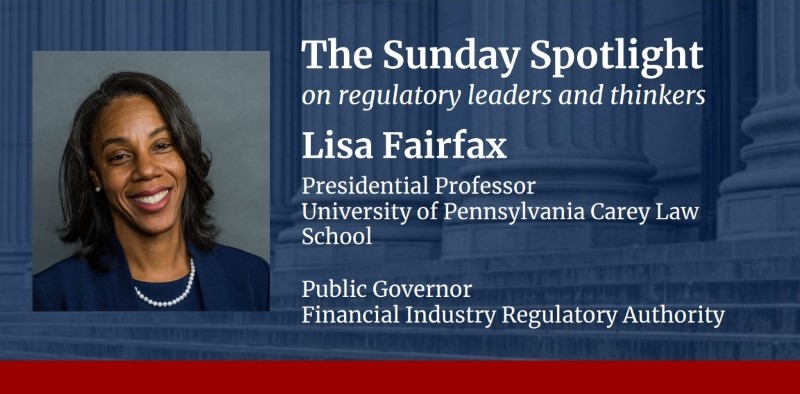
Lisa Fairfax explains how stakeholder concerns play a role in FINRA regulation, corporate governance, and ESG.
In a recent discussion with The Regulatory Review, Lisa Fairfax, Presidential Professor at the University of Pennsylvania Carey Law School and a public governor on the Board of Governors of the Financial Industry Regulatory Authority (FINRA), offers insight into timely corporate governance topics such as environmental, social, and governance (ESG) and “stakeholderism.”
She discusses, for example, how a broad range of stakeholder views helps to advance FINRA’s broader mission of serving the investing public through its oversight of brokerage firms. She also describes how the goals of ESG are sometimes misinterpreted as a tool to advance unrelated political goals. Fairfax argues that ESG is supposed to ensure that businesses consider a wide range of potential factors that may affect their financial performance.
In addition to teaching at the University of Pennsylvania Carey Law School, Fairfax co-directs the Institute for Law & Economics at Penn Carey Law, serves on the boards of the Institute for Law and Economic Policy and the Securities and Exchange Commission (SEC) Historical Society, and is a member of the American Law Institute and the Advisory Group for the American Law Institute Restatement of Law, Corporate Governance.
She has been awarded the Outstanding Mentor Award by the Business Associations Section of the American Association of Law Schools and the Trailblazer Award by the Minority Group Section of the American Association of Law Schools.
Prior to joining the University of Pennsylvania Carey Law School, Fairfax was the Alexander Hamilton Professor of Business Law at the George Washington University Law School, where she directed the George Washington Corporate Law and Governance Initiative. She also served on the Investor Advisory Committee of the SEC, was a member of the National Adjudicatory Council of FINRA, and served on the Committee on Corporate Laws of the Business Law Section of the American Bar Association.
The Regulatory Review is pleased to share the following interview with Professor Lisa Fairfax.
The Regulatory Review: Can you explain the role of FINRA and how it works with the SEC to regulate brokerage firms and exchange markets?
FINRA has been around for 85 years under a framework created by Congress. It regulates one critical part of the U.S. securities industry—brokerage firms doing business with the public. FINRA oversees about 3,600 brokerage firms and 630,000 registered individuals. FINRA’s mission is investor protection and market integrity. It provides education and compliance tools to investors and firms, writes rules governing day-to-day brokerage operations that augment the investor protections of the federal securities laws, and examines member firms for compliance with those rules and securities laws.
FINRA is a not-for-profit organization funded by industry fees, not by taxpayer dollars. FINRA leadership is not appointed by the government, but FINRA is closely supervised by the government and, in particular, by the SEC, which has a number of different programs that oversee FINRA’s operations and rulemaking. The SEC has a particular office dedicated to overseeing FINRA on an ongoing basis.
TRR: What do you see as some of the biggest challenges that financial regulatory or oversight organizations, such as FINRA, face today?
Most financial regulators are faced with challenges presented by an accelerated pace of change in markets, investment products, and how investors are communicating and consuming information. Fortunately, FINRA’s status as a self-regulatory organization has given it the ability to keep up with these changes and prepare for emerging risks.
As new markets have taken shape with an influx of new investment products, regulators must constantly reassess and adapt their rules and guidance, supervision, and enforcement. FINRA, for example, seeks to enhance its regulatory capabilities and expertise related to crypto assets, a $1 trillion market that attracts many first-time and young investors.
Meanwhile, FINRA is also undertaking efforts to safeguard investors amid changes in how investment scams are committed and how bad actors are victimizing investors, particularly senior investors. FINRA, for instance, introduced several new safeguards, including the first uniform, national standards to protect seniors.
TRR: What is the role of a “public governor” at FINRA? How is your role different from that of an industry member on the FINRA Board?
The FINRA Board oversees and provides advice and guidance to management in its administration of FINRA’s affairs. We review and approve all rulemaking proposals, FINRA’s budget, and other matters. All governors, whether public or industry, have the same duties—to act in FINRA’s best interest.
As a self-regulatory organization, FINRA is able to involve stakeholders more directly in its deliberations and benefit from their expertise, including expertise on different firm business models and how they operate, the complex and rapidly evolving securities markets, and the concerns of a wide range of investors. The same is true at the Board level. We bring our different perspectives to the same task of guiding FINRA’s pursuit of its mission to protect investors and ensure market integrity. When discussing a proposal, you would never know who is “public” or “industry”—we all advocate for the interests of the investing public and a vibrant industry.
TRR: You have written about stakeholderism, or the shift of corporate focus from shareholders to a broader set of stakeholders. How might a shift to stakeholderism affect the regulatory approach of organizations such as FINRA?
Stakeholderism is an important topic when applied to FINRA because the agency has always served the interests of a diverse group of stakeholders, including the firms they regulate, the investors they serve, and the government that oversees its operations. FINRA’s investor protection and market integrity mission means that FINRA must focus not only on broader societal issues that impact financial markets, but also on recruiting, retaining, and promoting a diverse array of employees who are essential to ensuring that FINRA can carry out its mission. FINRA has served these stakeholders over a period of decades and has done a lot in that time to ensure it works in the interest of all its stakeholders. That “public” versus “industry” split of the Board of Governors is one example. Its rulemaking process is also specifically designed to welcome the views of all stakeholders.
TRR: ESG considerations have become a point of increasing salience in recent years. Can you describe ESG and the impact it may have on corporations, investors, and the regulatory landscape?
Unfortunately, describing ESG and its impact is difficult because there is considerable confusion about the meaning of ESG—some people are convinced that ESG is about pushing corporations to advance political or social issues unconnected to legitimate business matters, while others insist that ESG is inextricably linked to long-term financial sustainability.
Those who coined the term ESG viewed it as a tool to assess material financial risks and opportunities. ESG is designed to capture the notion that because groups beyond shareholders and issues beyond short-term profits impact financial performance, corporations must consider and respond to those groups and issues to better ensure long-term financial sustainability. In other words, ESG matters to our corporate ecosystem because ESG issues, ranging from climate, the health, safety, and diversity of the workforce, and corporate governance, all have an impact on corporations, investors, and the regulatory landscape.
TRR: You have argued for the inclusion of mandatory disclosure requirements for ESG matters. You have also stated that regulatory bodies have historically not included disclosure requirements for corporations on important issues related to ESG. What do you see as the key contours of the debate today over requiring corporate disclosure of ESG issues? What are the strongest reasons for mandatory ESG reporting?
One of the most important aspects of the ESG debate is the need to clarify the importance of ESG for corporations and investors. I do not believe that ESG is about corporations pushing a political agenda. Instead, ESG aims to recognize the impact of environmental and social issues on financial performance. This means that ESG is linked to materiality and financial concerns.
For example, in addition to tragic loss of life, studies show that weather-related events—such as those currently occurring in the United States, which are growing in severity and frequency—have significant economic impact, including destroying physical and capital assets, disrupting supply chain and labor markets, undermining employee mobility and opportunity, and reducing overall economic activity and growth. As a result, the failure to consider and understand these economic impacts is both a risk and a lost opportunity.
This is why so many investors are interested in getting disclosure around ESG. Mandated disclosure is important for creating a baseline, facilitating cross-company comparisons, and increasing accuracy and accountability. Voluntary disclosure, however, is also important, especially for allowing greater flexibility and experimentation, and gap-filling. Thus, as I have written, the debate about voluntary versus mandatory disclosure represents a false choice because both are important to a robust disclosure landscape.
The Sunday Spotlight is a recurring feature of The Regulatory Review that periodically shares conversations with leaders and thinkers in the field of regulation and, in doing so, shines a light on important regulatory topics and ideas.



